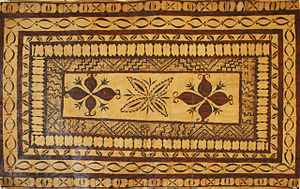 Tapa from the Lau Island Group of Fiji. (Photo credit: Wikipedia)
Tapa from the Lau Island Group of Fiji. (Photo credit: Wikipedia) Re-visualising innovative online learning spaces in an early childhood teacher education programme
Lesley Pohio and Maryann Lee (University of Auckland) started by introducing the initiative and then showed a short video of the students and the photographs they took when given access to a camera, and how they interacted with the environment and the communities. The video is shown to students when introducing early learning principles, especially around ownership of their own learning, engagement with each other, and focus on the learning process rather than the end product. These translate well to the online space.
The DVD was developed to contextualise learning (and features different foci around different ECE centres in Auckland). The context is important as it helps the student teachers consider learning outside the school gate. The use of visuals helped students think about and notice details of what they are taking images of, which illustrated understanding of their environment.
 Español: Caja de tapa y fondo (Photo credit: Wikipedia)Revisualising the online space began with thinking about visual fluency. There was a disparity between the face-to-face and the online experience, and the way in which the environment is seen as a third teacher. “...the space has to be a sort of aquarium that mirrors the ideas, values, attitudes, and cultures of the people who live within it....” (Edwards, et al, 1998, p. 177). The ECE was framed within the notion of the environment as a third teacher, where the environment is formed around more of a workshop type focus. This was the type of experience that they wanted to create around the online experience.
Español: Caja de tapa y fondo (Photo credit: Wikipedia)Revisualising the online space began with thinking about visual fluency. There was a disparity between the face-to-face and the online experience, and the way in which the environment is seen as a third teacher. “...the space has to be a sort of aquarium that mirrors the ideas, values, attitudes, and cultures of the people who live within it....” (Edwards, et al, 1998, p. 177). The ECE was framed within the notion of the environment as a third teacher, where the environment is formed around more of a workshop type focus. This was the type of experience that they wanted to create around the online experience.The challenge was developing such a rich environment within a Moodle environment. Topics were divided up into weekly chunks. As it was a beginning course they wanted to keep it quite structured. Four key things led to the design elements. The first was multiple design pathways (not a linear process, but rather it had lots of layers). There was online forums, practical tasks, and online journal, required texts, a video clip, and a variety of Internet resources. An artist was featured every week...not as a central course requirement, but rather as an appreciation of the visual arts. Even though it was a closed online course, they didn't want this to inhibit the learning of the students.
 Tapa (Photo credit: Wikipedia)
Tapa (Photo credit: Wikipedia)They were keen to infuse the skills and the environment with the pedagogical focus. The development of identities online was key as an initial step, and the focus was visual arts, which led to reflections around how these visual experiences had greater significance in the formation of their own identities. Alongside this, historical information was wrapped around a practical task, such as development of their own tapa. There were how to steps of technical skills, and then upload examples of their own work to share online. The aim was to broaden the notion of visual arts, rather than focus on activities – it is a holistic notion of visual arts.






No comments:
Post a Comment